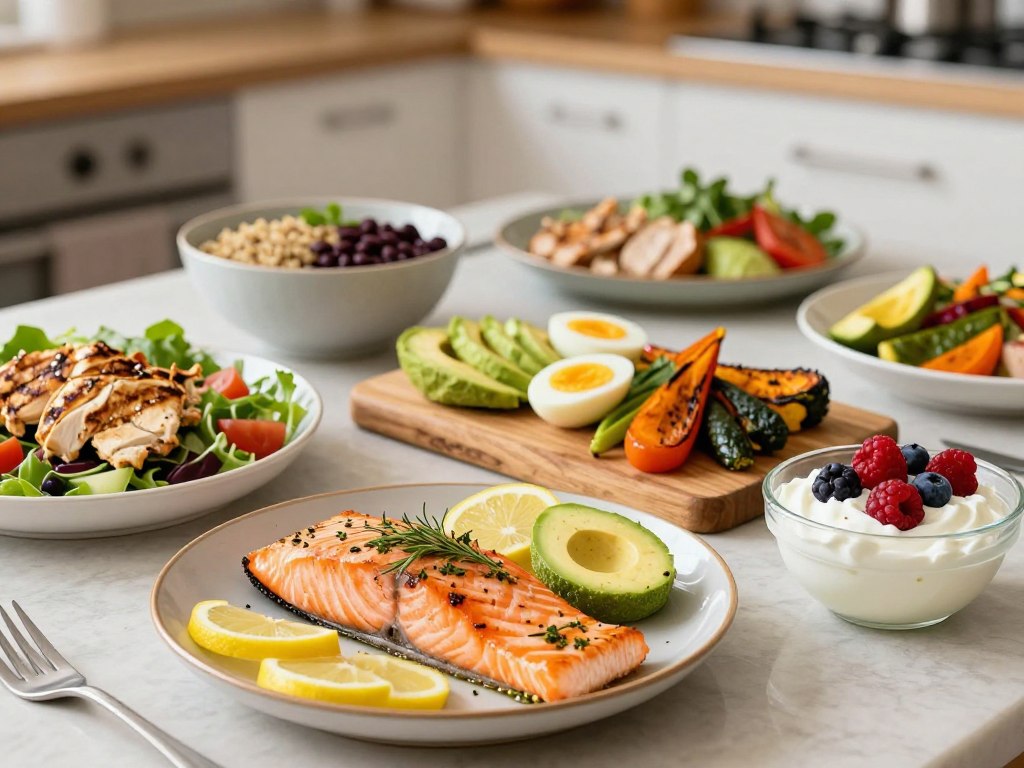As an Amazon Associate I earn from qualifying purchases.
How to Stay Healthy Without Dieting or Hustling
I still remember the countless times I’ve tried to overhaul my lifestyle. Each time, I ended up feeling overwhelmed and stuck. It’s a common struggle many of us face. We want to be healthier, but fad diets and exhausting workout routines get in the way.
As I navigated this journey, I realized something important. The key to a truly sustainable lifestyle isn’t about extreme measures. It’s about making small, meaningful changes that improve our overall wellbeing.

By taking a balanced approach, we can live a healthier lifestyle. It’s not about restrictive dieting or hustling too much. This mindset shift helps us understand health in a more holistic way.
Key Takeaways
- Embracing a balanced lifestyle is key to sustainable health.
- Avoid extreme measures and focus on small, meaningful changes.
- Cultivate a holistic understanding of health and wellbeing.
- Shift your focus from dieting to overall lifestyle improvements.
- Make conscious choices that foster long-term wellbeing.
The Problem with Diet Culture and Hustle Mentality
The endless chase for the perfect body and the praise for being busy have shaped a culture. This culture values looks and work over health and joy. It affects our physical and mental health deeply.
Why Traditional Diets Often Fail
Traditional diets focus on cutting out foods, leading to guilt and shame. When we can’t stick to them, we feel bad and angry. Studies prove these diets harm our health in the long run.
| Diet Approach | Short-term Effects | Long-term Effects |
|---|---|---|
| Restrictive Dieting | Initial weight loss | Weight regain, nutrient deficiencies |
| Balanced Eating | Sustainable weight management | Improved overall health, reduced risk of chronic diseases |
The Burnout Cycle of Constant Hustle
The need to always be busy can exhaust us. This exhaustion comes from wanting more and never stopping. It leaves no time for rest.
The Mental and Physical Toll of Restrictive Approaches
Too much dieting and exercise can harm our minds and bodies. It causes stress, anxiety, and depression. It can also lead to nutrient shortages and chronic fatigue.
Knowing the dangers of diet culture and hustle can help us change. We can move towards a healthier, more balanced life.
Wellness Without Dieting: No Diet, Healthy Habits & Non-Diet Approach to Health
The journey to wellness without dieting is a big change. It’s about moving away from old diet ideas. Instead, we focus on a more complete way of being well.
A non-diet approach to health means adopting habits that help us stay healthy. It’s not about strict diets. This method is getting attention for its lasting benefits and good effects on mental health.
The Science Behind Sustainable Health
Studies show that lasting health comes from habits we can keep up. A study in a top health journal found that slow, steady changes lead to better health and weight loss. This is better than quick fixes or trendy diets.
The key to sustainable health is not about being on a diet, but about making healthy habits a part of your lifestyle.”
Shifting from Weight Focus to Wellbeing
The non-diet approach focuses on overall well-being, not just weight loss. It’s about choosing balanced lifestyle tips that improve both body and mind. This helps us have a better relationship with food and our bodies.
Setting Realistic Health Goals
Setting realistic health goals is key to lasting health. It’s about finding goals we can reach without feeling like we’ll fail. By focusing on no diet healthy habits like exercise, balanced eating, and managing stress, we build a strong base for long-term health.
We can live a healthier, more balanced life by taking this path. It’s not about dieting or extreme measures. It’s about finding a lasting way to be healthy that focuses on overall wellbeing.
Step 1: Develop Intuitive Eating Practices
Listening to your body’s hunger and fullness cues, you can build a better relationship with food. This method is about listening to your body and meeting its needs. It’s not about following strict rules or diets.
Learning to Recognize Hunger and Fullness Cues
Start by noticing when you’re hungry or full. Pay attention to your body’s signals, not just when it’s time to eat. Eat slowly and enjoy your food to understand its taste and texture.
Recognizing Hunger Cues: Hunger feels like a growling stomach or feeling lightheaded. By listening to these signs, you can eat when you’re hungry, not just because you’re bored.
Breaking Free from Food Rules and Restrictions
We often follow food rules that make us feel trapped. These rules can make us feel deprived. Breaking free from these rules helps you enjoy food more.
It’s freeing to stop judging foods as “good” or “bad”. Focus on eating a variety of healthy foods. Also, let yourself enjoy treats in moderation.
Creating a Peaceful Relationship with Food
Eating peacefully is more than just the food. It’s also about where and how you eat. Eat in a calm place, without distractions, and enjoy the moment.
Practical Exercises to Build Food Awareness
- Keep a food diary to track your eating habits and identify patterns.
- Practice mindful eating by focusing on the sensations of eating.
- Experiment with different flavors and textures to expand your palate.
Here’s a comparison to show the benefits of intuitive eating:
| Traditional Dieting | Intuitive Eating |
|---|---|
| Restrictive and often leads to feelings of deprivation | Nourishing and flexible, allowing for the enjoyment of all foods |
| Focuses on external rules and restrictions | Focuses on internal cues and listening to the body |
| Can lead to an unhealthy relationship with food | Fosters a positive and peaceful relationship with food |
By using these practices, you can develop a healthier and more loving relationship with food. This leads to better overall well-being.
Step 2: Embrace Joyful Movement Instead of Punishing Exercise
Good health doesn’t come from hard workouts. It’s about finding fun physical activities. This makes staying active easier and turns exercise into something enjoyable.
Discovering Activities That Bring You Joy
Start by trying different physical activities to find what you like. You might enjoy dancing, swimming, or cycling. Or maybe hiking, yoga, or gardening. The goal is to find activities that make you feel good.
Try out different exercises to see what you like best. You might prefer team sports or solo activities. The most important thing is to enjoy it, not just do it because you have to.

The Benefits of Moderate and Consistent Movement
Regular, moderate exercise is very beneficial. It improves heart health, mental well-being, and strength. It also boosts your energy and helps you sleep better.
Some key benefits of moderate movement include:
- Enhanced cardiovascular health
- Improved mental health and mood
- Increased strength and flexibility
- Better sleep quality
| Activity | Benefits | Frequency |
|---|---|---|
| Yoga | Flexibility, Stress Relief | 2-3 times a week |
| Cycling | Cardiovascular Health, Leg Strength | 3-4 times a week |
| Swimming | Full Body Workout, Low Impact | 2-3 times a week |
Building an Exercise Routine Without Burnout
Start slow and be consistent for a lasting exercise routine. Gradual progress is better than pushing too hard. This way, you avoid burnout and are more likely to keep up with your routine.
Sample Movement Plans for Different Lifestyles
You can create a movement plan that fits your life. If you’re busy, try shorter, intense workouts. If you have more time, choose longer activities.
Here’s a simple plan for different lifestyles:
- For busy professionals: 20-minute morning yoga or brisk walking
- For families: Weekend hiking or cycling trips
- For seniors: Gentle stretching exercises or water aerobics
By choosing joyful movement, you can live a healthy life without stress. You’ll develop habits that make you feel good.
Step3: Implement Simple Daily Habits for Lasting Wellness
Focus on simple, daily habits to live healthier without feeling stressed. This method is all about being consistent, not intense. It helps you stick to it for the long haul.
Optimizing Sleep and Hydration
Good sleep and enough water are key to health. Aim for 7-9 hours of sleep each night and drink plenty of water. Start a bedtime routine to sleep better. Carry a refillable water bottle to stay hydrated.
| Daily Habit | Benefits | Tips for Implementation |
|---|---|---|
| Drinking 8+ glasses of water | Boosts energy, improves skin health | Keep a water bottle visible, set reminders |
| Getting 7-9 hours of sleep | Enhances mental clarity, supports immune function | Establish a bedtime routine, avoid screens before bed |
Stress Management Techniques That Actually Work
It’s vital to manage stress well for health. Try mindfulness meditation and deep breathing exercises to lower stress. Adding these to your daily life can boost your mental and physical health.
Creating a Supportive Environment and Community
Your surroundings and community affect your health habits. Be around supportive people and have a clean living space. This could mean decluttering and finding friends who care about health like you.
Daily Wellness Checklist for Busy People
- Drink at least 8 glasses of water
- Get 7-9 hours of sleep
- Practice stress-reducing techniques (e.g., meditation, deep breathing)
- Engage in some form of physical activity
- Connect with a friend or family member
Adding these simple habits to your day can greatly improve your health. The secret is to be consistent and make small, lasting changes.
Conclusion: Your Sustainable Path to Health Without Extremes
Getting healthy without dieting is a journey. It’s about building good habits, not strict diets or too much exercise. This way, you can live a balanced and lasting life.
We’ve talked about the key to this journey. It includes eating when you’re hungry, moving with joy, and doing simple daily habits. By focusing on being well, not just thin, you’ll love your body more.
Intuitive wellness is about being kind to yourself and caring for your well-being. It’s about making small changes that lead to big improvements. By adding these habits to your day, you’ll stay healthy and balanced.
Remember, wellness is a journey, not a goal. Celebrate every small win. Focus on moving forward, not being perfect.
FAQ
What is intuitive eating, and how can it help me stay healthy without dieting?
Intuitive eating means listening to your body’s hunger and fullness signals. It’s about eating without following strict rules. This approach helps you have a better relationship with food and your body. It also lowers the risk of unhealthy eating habits and boosts your overall health.
How can I make exercise a sustainable part of my lifestyle without feeling like I’m “hustling”?
Focus on enjoying your workouts, not just doing them. Find activities that make you happy, like dancing or swimming. This way, exercise becomes something you look forward to, not a chore.
What are some simple daily habits I can implement to support my overall health and wellbeing?
Start with small habits like getting enough sleep and staying hydrated. Also, manage stress well and surround yourself with positive people. Begin with one or two habits and add more as you get comfortable.
How can I manage stress without feeling overwhelmed?
Find what works for you, like meditation or yoga. Make time for relaxation and self-care. This helps reduce stress and improves your overall wellbeing.
Can I really achieve sustainable health without following a specific diet or fitness plan?
Yes, you can. Focus on habits like intuitive eating and joyful movement. Simple daily habits also play a big role. It’s about living a balanced life that cares for your body, mind, and spirit.
How long does it take to develop healthy habits that stick?
Building healthy habits takes time and effort. Start small and stay consistent. Remember, it’s a journey, not a goal. Focus on making progress, not being perfect.
Amazon and the Amazon logo are trademarks of Amazon.com, Inc or it's affiliates.
Related Posts
- 10 Simple Habits for a Healthier Lifestyle
10 simple habits that have helped me live a healthier, happier lifestyle.
- Homemade Healthy Granola Recipe
Homemade Healthy Granola Recipe The Ultimate Healthy Granola Delight In the pursuit of a wholesome…
- Making Healthy Eating Affordable
Making Healthy Eating Affordable Tips for Meal Planning, Grocery Shopping, and Cooking at Home When…





